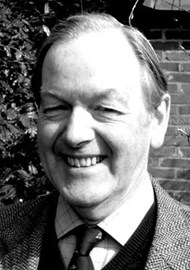Paris was the birthplace of the laryngoscope, invented by Manuel Garcia. As we are in Paris for IFOS 2017, Neil Weir tells us about this fascinating man, who travelled the world and was a renowned singer and laryngologist.
Manuel Patricio Rodriguez Garcia was born on 17 March 1805, either in Madrid or Zafra in Badajoz Province in southwestern Spain, the son of Manuel del Pópulo Vicente Garcia (1775-1832), known as ‘the Senior’; a famous tenor, impresario, composer, and singing teacher. Both his sisters, Maria Malibran (1808-1836) and Pauline Viardot (1821-1910), were to enjoy distinguished operatic careers.
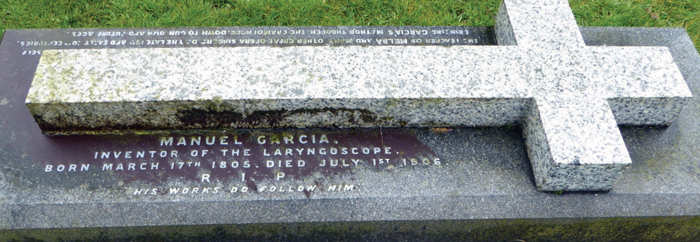
Manuel Garcia’s gravestone at St Edward the Confessor Church, Sutton Park, Guildford.
Manual Garcia Junior spent most of his early life with his grandparents in Madrid, sheltered from the Napoleonic wars, whilst his father established his singing career in Paris, Naples and London and composed his own light operas - over 40 in all (17 in Spanish, 19 in Italian and seven in French). In Naples, he was befriended by Gioachino Rossini (1792-1868) who wrote for him the leading tenor roles in Elizabeth, Queen of England (1815) and the Barber of Seville (1816). In response to a request from Lorenzo Da Ponte - the librettist and professor of Italian at Columbia College, New York - the two Manuels, Maria Garcia, and Manuel Senior’s second wife, Joaquina Sitchez, formed the core of a company that sang the first performances of Italian opera in New York (1825-1826).
Da Ponte insisted on billing Mozart’s Don Giovanni for which he had written the libretto. From New York, the troupe travelled to Mexico where they had hoped to settle. This was not to be as they were robbed of most of the takings from their New York shows.
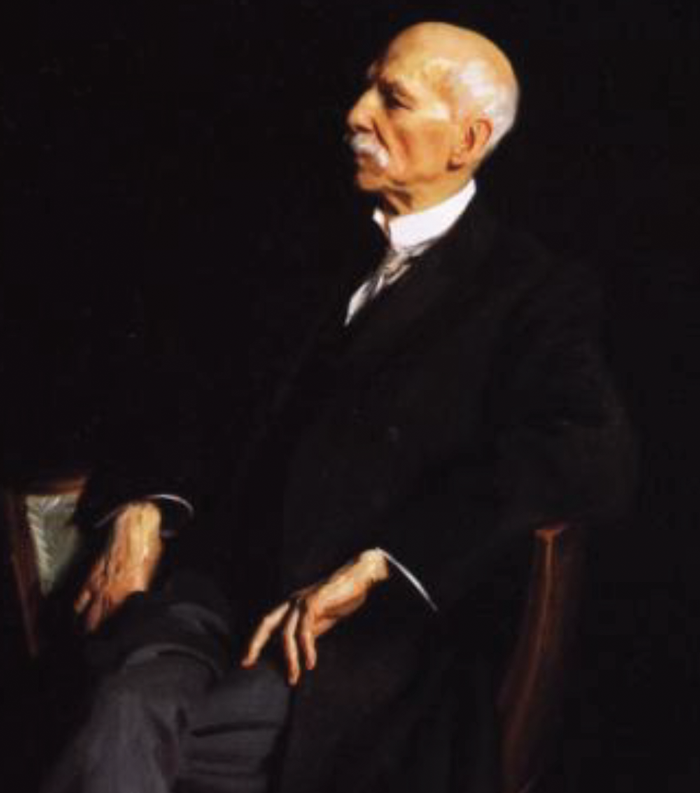
Manuel Garcia, age 100, by John Singer Sargent RA. This picture is
displayed in the Duke’s Hall, Royal Academy of Music, London.
By this time it was beginning to be apparent to Manuel Junior that his baritone voice lacked strength and, on returning to Paris in the autumn of 1827, he decided that he wanted to explore his growing interest in science and, in particular, anatomy. An initial impulse to go to sea to learn astronomy and navigation was thwarted by the family so, for a while, Manuel Junior joined his father’s teaching classes. Now 25 years old, he decided to leave Paris and his overbearing parents for a short military career in Algiers.
With further unrest in Paris, Manuel Junior used his military connections to attach himself to a military hospital where, in an attempt to learn the science of singing, he collected the larynges of chickens, sheep and cows and, with the aid of a set of bellows, blew air through them, producing a surprising variety of sounds.
“The manner in which the glottis silently opened and shut and moved in the act of phonation, filled me with wonder.”
Thus, the first stage of Manuel Junior’s long life was completed: he had sung in opera and in the concert hall; he had started teaching singing; and he had attempted to seek out some scientific understanding of the voice. In 1830, two years before the death of his father, he established himself as a scientific singing master and in 1835 was appointed a professor at the Paris Conservatory.
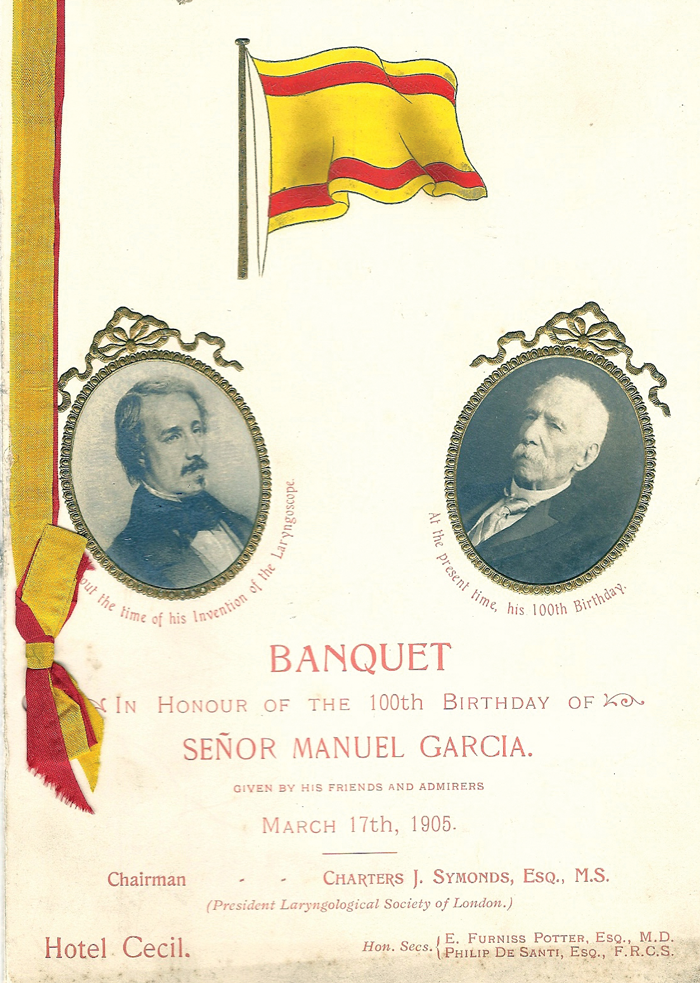
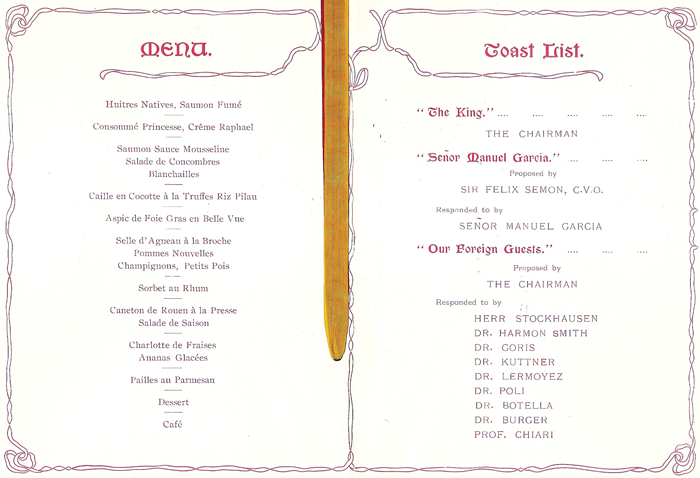
The original menu card for the huge banquet given to honour Manuel Garcia on his 100th birthday.
It runs to 11 courses and coffee!
His reputation grew rapidly and young ambitious singers saved their money to apply to be his pupils. Among these was Johanna Maria (Jenny) Lind (1820-1887) who was to become one the most famous sopranos of the middle of the 19th century. She had had a meteoric start to her career in Sweden. Educated at the expense of the directors of the Stockholm theatre, without regard as to whether her voice was suited to her ambitious repertoire, she had strained her voice. This was found to be very apparent at her first performance in a Paris salon, at which Manuel Garcia was present. Still only 21 years old, she sought his help. He asked her to sing a piece from Donizetti’s Lucia di Lammermoor. She broke down despite having performed the work in Stockholm.
Garcia recommended a six-week total voice rest and then gradually helped her to rebuild her voice and refine her technique. She undertook two one-hour lessons a week for a year at the cost of 20 francs per hour. Having been advised by Garcia not to attempt a debut at the Paris Grand Opera for five years, she returned home to Stockholm in even better voice and, in 1847, made her debut in London, where she was named the ‘Swedish Nightingale’.
Meanwhile, Garcia had enhanced his academic status with a publication submitted in 1840 to the Académie des Sciences de France entitled, Mémoire sur la Voix Humain. In this paper he revealed that the head voice did not necessarily begin where the chest voice ended – there was a transition where a certain number of notes could be produced in either register. This well-received paper was followed by the publication Ecole de Garcia: Traité Complet de l’Art du Chant (part one 1840; part two 1847) in which Garcia cleared up the confusion that had hitherto existed between ‘timbres’ and ‘register’.
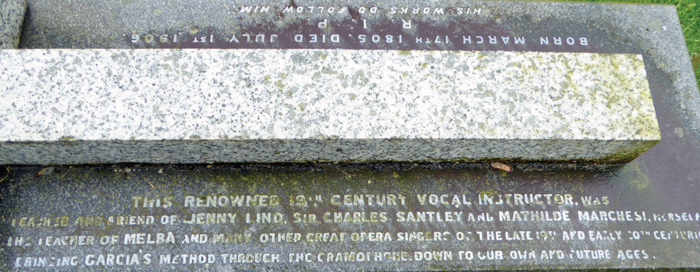
Manuel Garcia’s gravestone with names of his famous pupils.
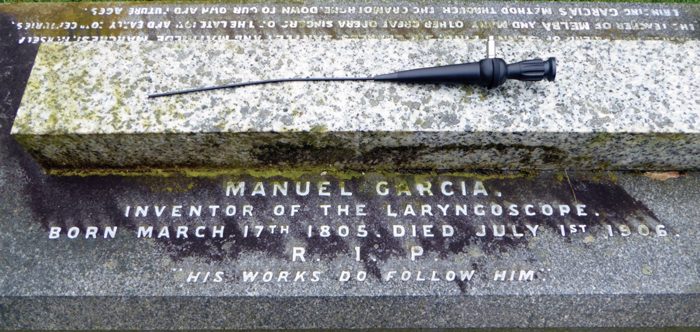
Manuel Garcia’s gravestone with fibreoptic nasolaryngoscope.
In February 1848, revolution flared up again in Paris, with the result that King Louis-Phillipe fled to England disguised as ‘Mr Smith’, and the Second Republic was proclaimed. Manuel Garcia, who had witnessed the political unrest before, decided after an intense battle between the Republicans and the National Guard in late June, to move to London where he had, over many years, established good connections. He was quickly appointed to the staff of the Royal Academy of Music and remained in England for the rest of his very long life.
Manuel Garcia had, for years, harboured a desire to see a ‘healthy glottis exposed in the very act of singing’. His discovery of autolaryngoscopy was included in a paper, entitled ‘Physiological Observations on the Human Voice’, which was communicated to the Royal Society on his behalf by the physiologist, William Sharpey, on 24 May 1855.
How he made his discovery is now legend. It was related by Garcia himself in 1881: “One September day in 1854, I was strolling in a garden of the Palais Royal, preoccupied with the ever-recurring wish so often repressed as unrealisable, when suddenly I saw the two mirrors of the laryngoscope in their respective positions, as if actually present before my eyes”. He had observed the sun flashing on the window panes of the 17th century quadrangle. “I went straight to Charrière [Joseph (1803-1876)], the surgical instrument maker” - on the recommendation, it is said, of his friend Cavaillé-Col, the Parisian organ builder […] “and, asking if he happened to possess a small mirror with a long handle, was informed that he had a little dentist’s mirror, which had been one of the failures of the London Exhibition of 1851. I bought it for six francs. Having obtained also a hand mirror, I returned home at once, very impatient to begin my experiments. I placed against the uvula the little mirror (which I had heated in warm water and carefully dried) and by flashing upon its surface with a hand mirror a ray of sunlight, I saw at once, to my great joy, the glottis wide open before me, and so fully exposed that I could perceive a portion of the trachea. When my excitement had somewhat subsided, I began to examine what was passing before my eyes. The manner in which the glottis silently opened and shut, and moved in the act of phonation, filled me with wonder.”
“He had never meant to become the founder of a new medical specialty, and he protested that the mirror had only cost him six francs.”
How was it that Manuel Garcia succeeded where all the extensive attempts to view the glottis before had failed? The answer lies in the fact that Manuel Garcia was himself a singer with a trained voice, accustomed to controlling his pharyngeal muscles, and that he chose a simple instrument to introduce into his throat.
The French anatomist and tenor, Louis-Auguste Segond (1819-1908), wrote an annotation of Garcia’s communication to the Royal Society in 1855 and remarked that: “M Garcia has the faculty of supporting in the pharynx and at the isthmus of the fauces the prolonged contact of foreign bodies without provoking in him efforts of vomiting. He was then able, in putting a mirror into the pharynx, to maintain it to receive the image of the glottis.” The French physician, Charles-Paul Diday (1812-1894) in commenting Segond’s annotation, added: “As for the ingenious procedure by which he [Garcia] was able to see the glottis is in function, I hope indeed soon to be in a positon to repeat it myself.”
Manuel Garcia’s discovery shared the same fate as befell the London physician, Benjamin Babington’s, ‘glottiscope’ in 1829; it was treated with apathy and even incredulity. Recognition eventually came from the medical profession in 1862 when the degree of Doctor of Medicine was conferred upon him by the University of Königsberg.
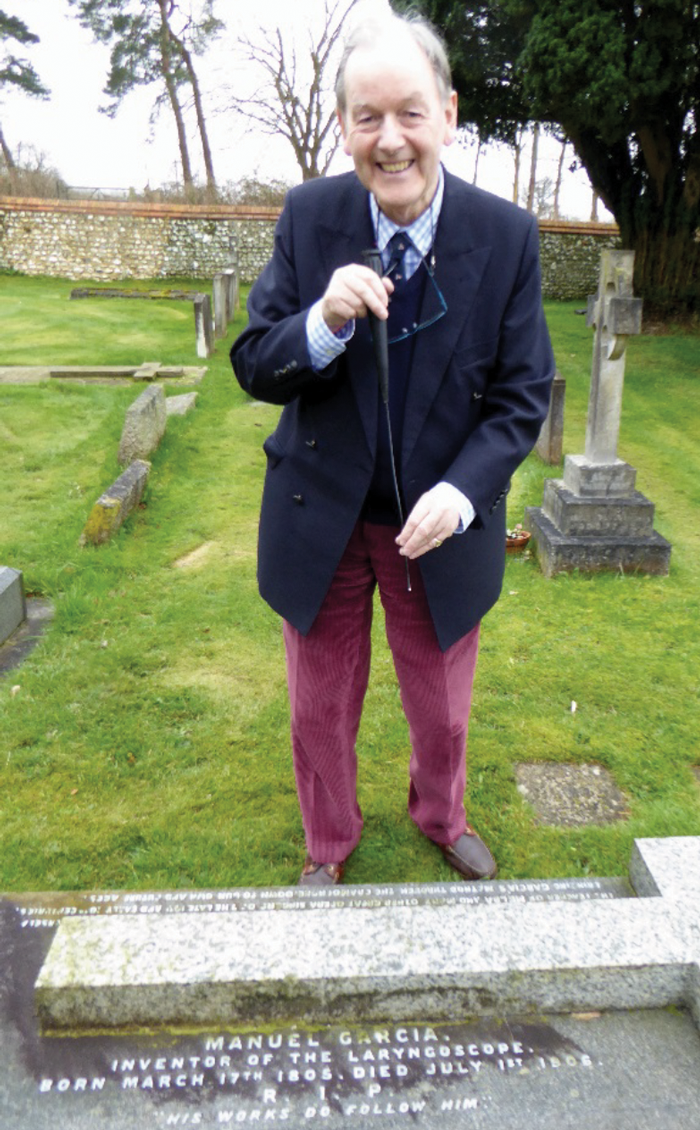
Neil Weir with his fibreoptic nasolaryngoscope at the graveside of Manual Garcia.
He became a director of the Royal Academy of Music in 1878 and, when he reached the age of 100 on 17 March 1905, Sir Felix Semon organised a celebration in his honour at the premises of the Royal Medical and Chirurgical Society, London. Delegates were present from universities, medical schools, colleges of music and scientific societies from all over the world. In the morning, King Edward VII invested him with the insignia of Commander of the Royal Victorian Order. At the reception, the Spanish Ambassador decorated him with the Royal Order of Alfonso XII and Professor Bernhard Fraenkel of Berlin handed him the Great Gold Medal for Science, awarded by the German Emperor.
The highlight was the unveiling of his portrait presented by a group of leading British and American laryngologists and painted by the most popular artist of the day, John Singer Sargent RA. The old man was said to have been very touched and amused by all the attention given to him and wondered what all the fuss was about. He had never meant to become the founder of a new medical speciality, and he protested that the mirror had only cost him six francs! He died on 1 July in his 102nd year and is buried in the churchyard adjoining St Edward the Confessor Church, Sutton Park, Guildford.

